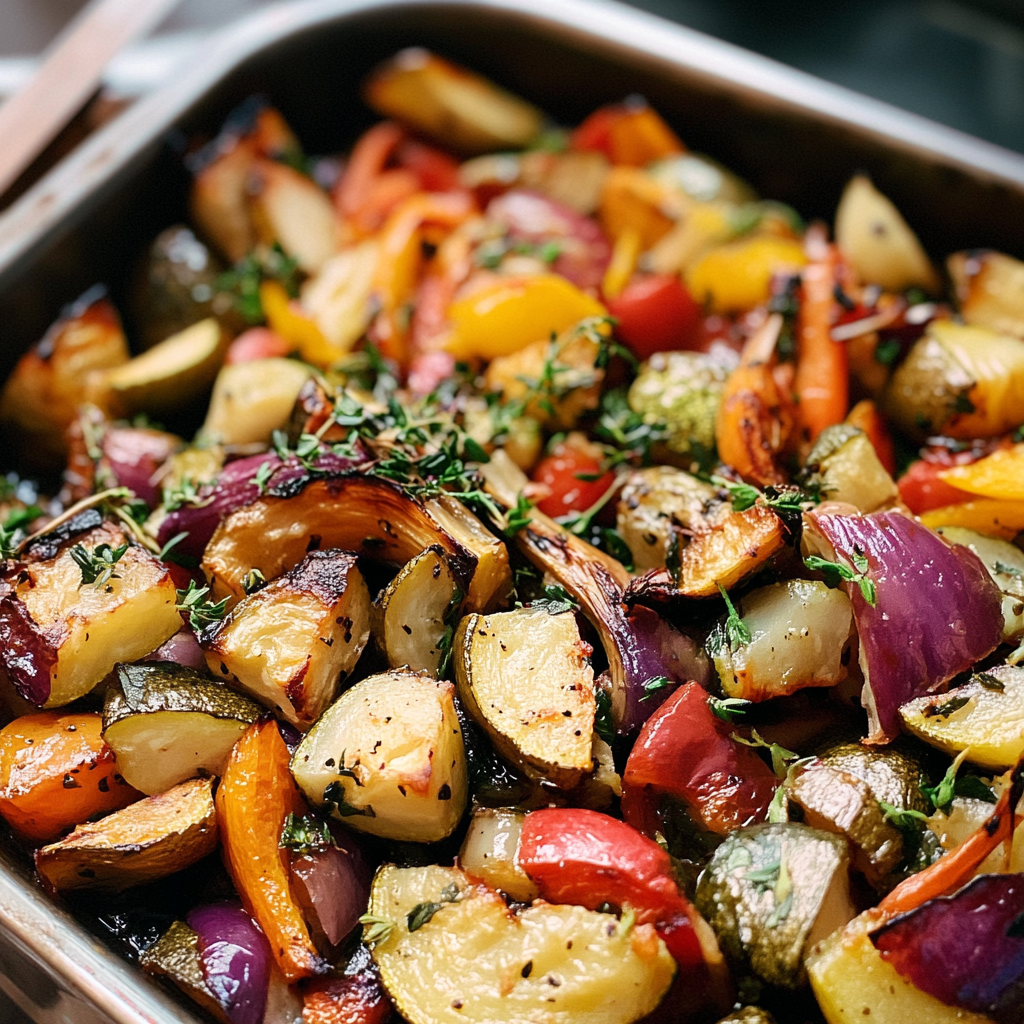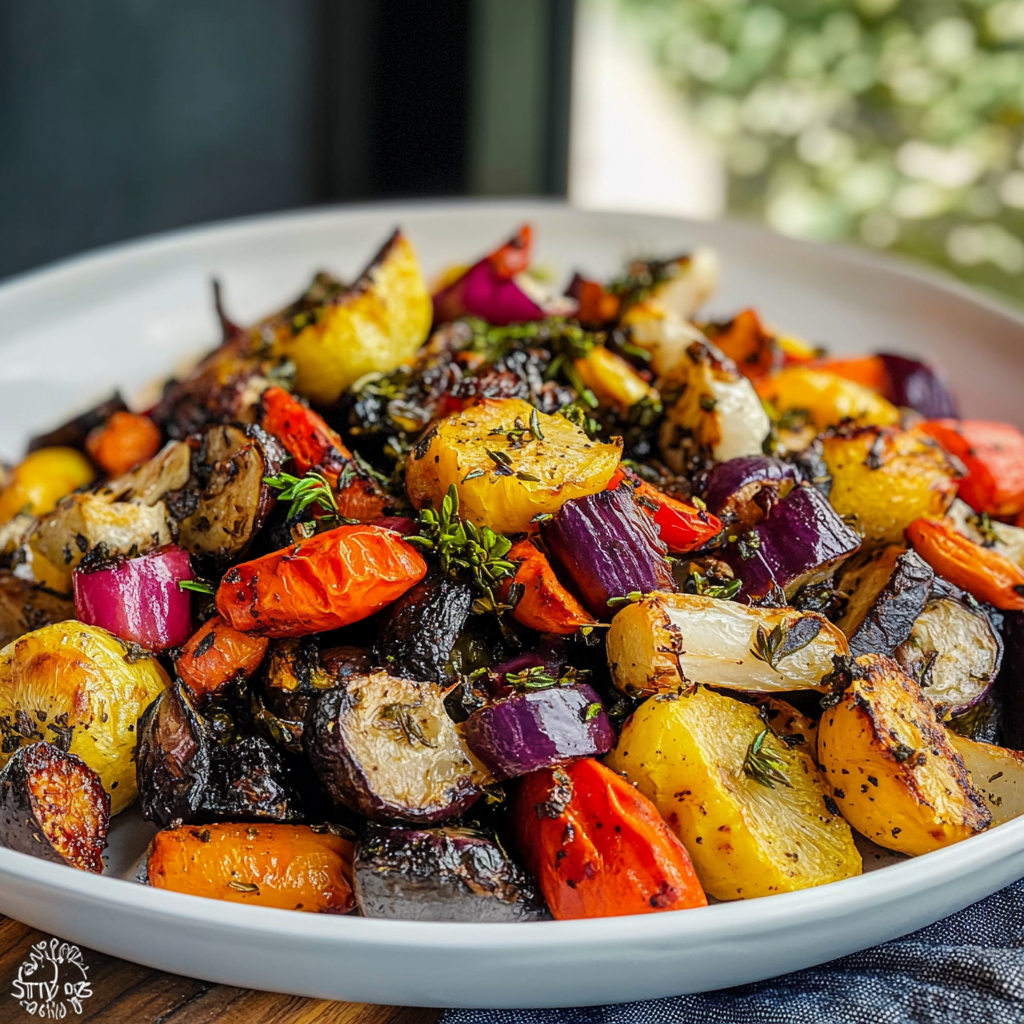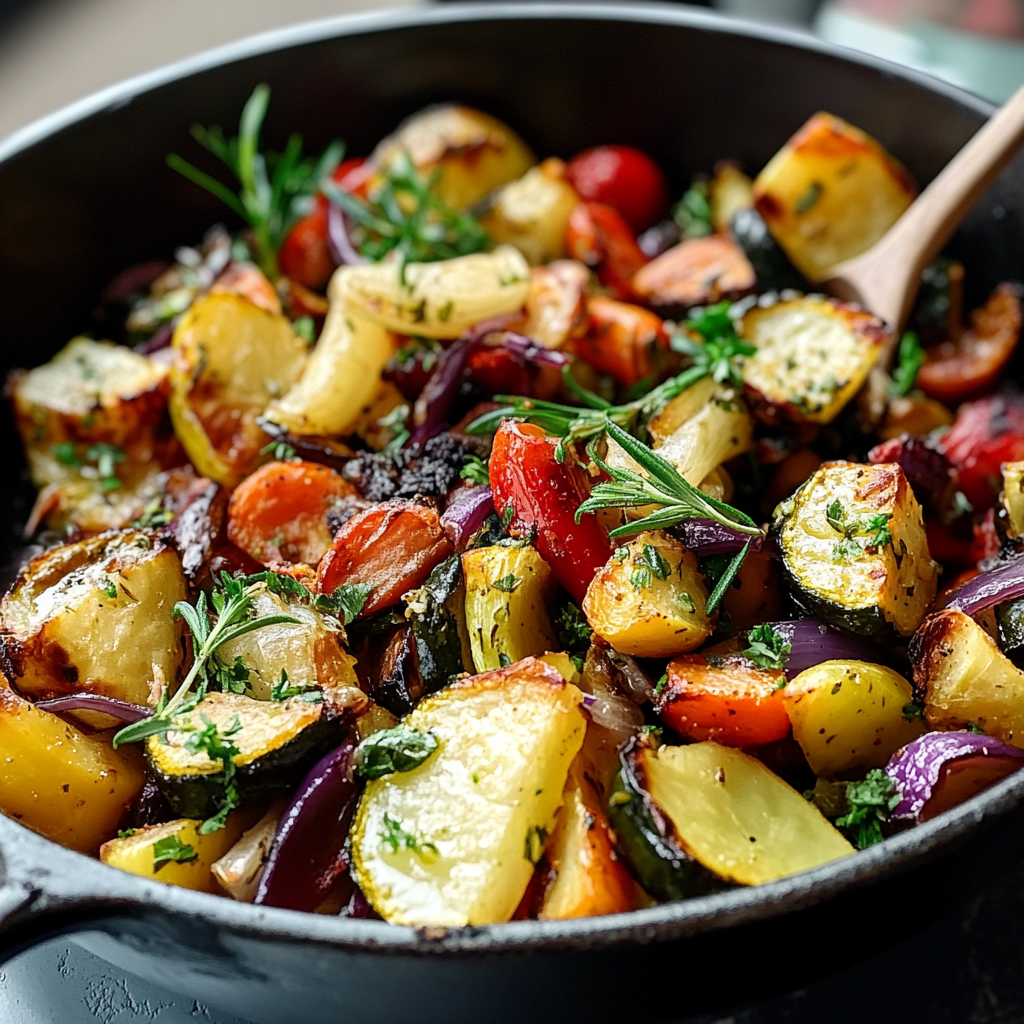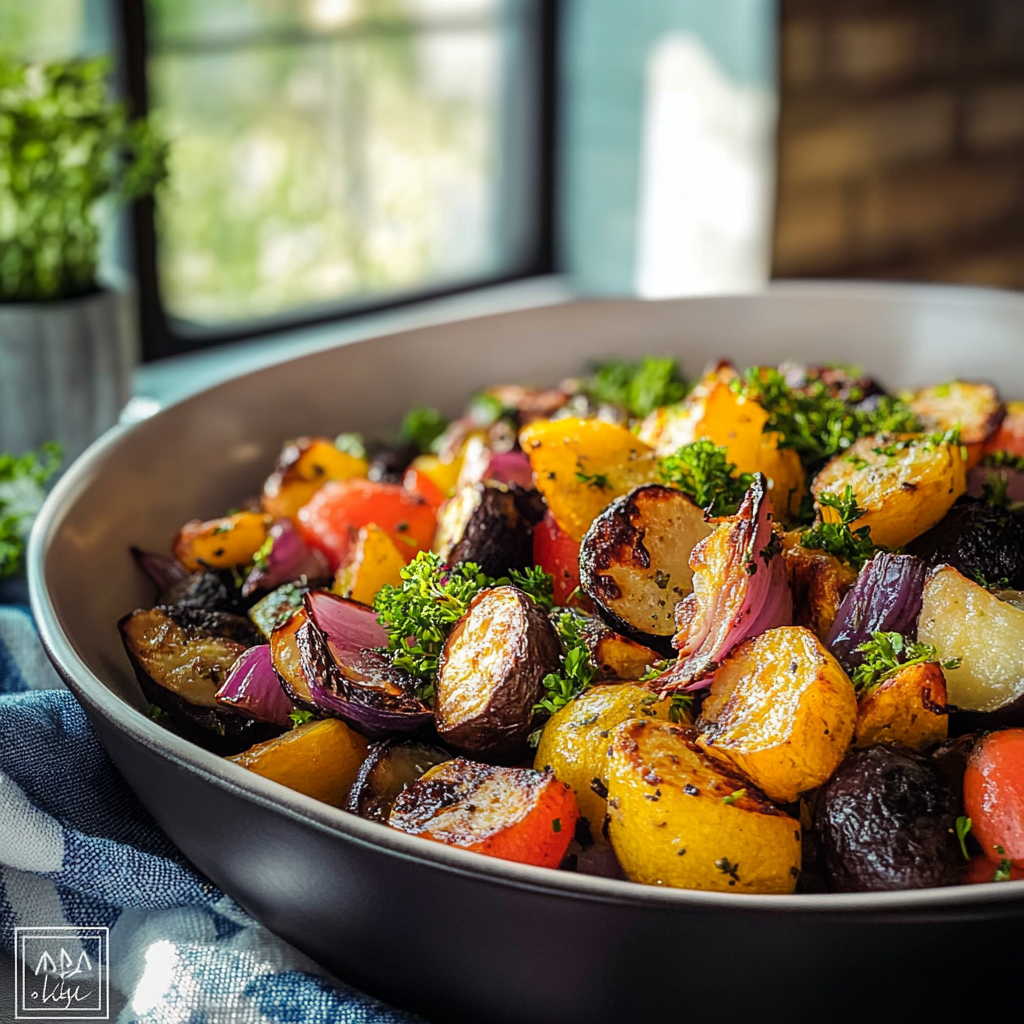Introduction and Quick Summary
Roasted vegetables with herbs are a delightful dish that not only enhances the flavor of your meals but also makes them more nutritious. This simple yet versatile recipe allows you to customize the selection of veggies based on what’s in season or what you have on hand. Whether you’re preparing a weeknight dinner or hosting a gathering, these herbed roasted veggies will surely impress your guests and family alike.

The beauty of this recipe lies in its simplicity and ease of preparation. You can choose from a variety of colorful vegetables such as bell peppers, carrots, zucchini, and red onions. The key to achieving that mouth-watering taste is in the fresh herbs used; rosemary, thyme, and parsley work beautifully together to elevate the natural flavors of the vegetables.
In this article, we will walk you through the essential ingredients needed for this dish and provide detailed instructions on how to prepare it perfectly every time. Plus, we’ll include serving suggestions and tips for storing leftovers to keep your meals fresh throughout the week. Get ready to fill your kitchen with delightful aromas and enjoy a plateful of delicious roasted vegetables with herbs!
Main Ingredients
Fresh Seasonal Vegetables
For this recipe, choose about 4 cups of fresh seasonal vegetables. Some excellent options include bell peppers (red, yellow, or green), zucchini, carrots, cherry tomatoes, and red onions. Each vegetable brings its unique texture and flavor profile to the dish. Aim for a mix of colors to create an appealing presentation.
Olive Oil
Use approximately 3 tablespoons of quality extra virgin olive oil. This oil not only adds richness but also helps in roasting the vegetables evenly. The healthy fats from olive oil enhance the absorption of vitamins from the veggies while contributing a lovely taste that complements the herbs.
Fresh Herbs
You will need about 2 tablespoons each of chopped fresh rosemary and thyme for this recipe. These aromatic herbs impart a fragrant essence that elevates the dish’s overall flavor. Fresh herbs provide a more robust taste compared to dried ones and make your roasted vegetables truly exceptional.
Salt and Pepper
A pinch of salt (about 1 teaspoon) and freshly ground black pepper (to taste) are essential seasoning components for enhancing flavors in your dish. Adjust according to your preference; salt should bring out the natural sweetness of the veggies while pepper adds an earthy note that balances everything perfectly.
Garlic
Incorporate 3 cloves of minced garlic into your mix for added depth and aroma. Garlic infuses each bite with its savory notes while complementing the freshness brought by herbs and spices. It’s advisable not to skip garlic as it’s integral in creating that irresistible flavor profile everyone loves.

How to Prepare Roasted Vegetables with Herbs
Step One: Preheat Your Oven
Begin by preheating your oven to 425°F (220°C). Preheating is crucial as it ensures even cooking throughout all ingredients when they hit the hot surface; thus promoting caramelization which intensifies flavors beautifully! While waiting for it to reach temperature, prepare your baking sheet by lining it with parchment paper or lightly greasing it with cooking spray—this will prevent sticking during roasting.
Step Two: Prepare Your Vegetables
While the oven is heating up, wash all selected seasonal vegetables thoroughly under running water. Afterward, chop them into uniform pieces—aiming for about one-inch chunks—to ensure they roast evenly at approximately the same rate without some burning while others remain raw. Place cut veggies into a large mixing bowl; this will allow better seasoning distribution later on.
Step Three: Season Your Vegetables
Drizzle olive oil over your prepared vegetable mixture—ensuring every piece gets coated well—and toss gently until all veggies glisten evenly without excess pooling at bottom; too much oil can lead them becoming soggy rather than crispy! Next sprinkle salt & pepper along with chopped rosemary & thyme over top; mix again until everything looks deliciously seasoned before transferring onto lined baking sheet—spread evenly out rather than piling high so they roast rather than steam.
Step Four: Roast Them Perfectly
Once arranged on prepared baking sheet place it directly into preheated oven! Allow roasting for about 25-30 minutes but remember halfway through take time (around 15 minutes) check progress by stirring gently; this promotes even browning across all sides allowing those deep caramelized edges everyone loves! When finished cooking remove from heat source ensuring tender but slightly crisp texture achieved throughout before letting cool slightly before serving up!

Serving and Storing Tips
Serving Suggestions
These beautiful roasted vegetables pair wonderfully with many main dishes like grilled chicken or fish; alternatively serve as part standalone vegetarian meal alongside quinoa or couscous! Drizzle additional balsamic glaze atop prior presenting guests if desired—it adds an extra layer complexity elevating flavors tremendously! Consider garnishing finished plate with sprinkling fresh parsley right before serving adding pop color presentation-wise making every bite delightful!
Storage Guidelines
To store leftovers effectively after enjoying this scrumptious dish let them cool completely before transferring into airtight container suitable for fridge storage lasting up five days maximum! For longer-term storage consider freezing portions allowing access quick weeknight dinners simply reheat within microwave safe bowl ensuring maintain original taste textures afterward! Freezing works best when portioned out properly preventing freezer burn affecting overall quality product upon reheating later down line!
By following these guidelines you’ll enjoy delicious roasted vegetables infused rich flavors enhanced simply through use quality ingredients preparation methods ensuring satisfaction every time served!
Mistakes to avoid
When preparing roasted vegetables with herbs, it’s crucial to steer clear of common mistakes that can impact the flavor and texture of your dish. One major pitfall is overcrowding the baking sheet. When you place too many vegetables on one tray, they steam instead of roast. This results in soggy vegetables rather than the desired crispy texture. To avoid this, ensure there’s enough space between each piece, allowing hot air to circulate freely.
Another mistake is failing to season adequately. Vegetables can taste bland if you skip the seasoning step or don’t use enough herbs and spices. Season generously with salt and pepper before roasting, and consider adding olive oil or melted butter for richness. Don’t forget to incorporate fresh or dried herbs, like rosemary or thyme, which enhance the flavor profile significantly.
Additionally, neglecting to cut vegetables into uniform sizes can lead to uneven cooking. Different sizes will roast at different rates; smaller pieces may burn while larger chunks remain raw. Aim for similar-sized cuts for even cooking.
Lastly, be mindful of roasting times and temperatures. Each vegetable has its ideal roasting time; for instance, softer vegetables like zucchini cook faster than denser ones like carrots. Monitor your vegetables closely to ensure they don’t overcook or undercook.

Tips and tricks
To elevate your roasted vegetables with herbs, consider these helpful tips and tricks. First, preheat your oven adequately before placing the vegetables inside. A well-heated oven ensures that your veggies start roasting immediately upon entry, promoting caramelization and enhancing flavors.
Using a variety of seasonal vegetables can add depth and interest to your dish. Mixing colors, textures, and tastes creates a visually appealing plate while also providing different nutritional benefits. Incorporate root vegetables like sweet potatoes alongside cruciferous options like Brussels sprouts for a balanced mix.
Experimenting with various herbs can also make a significant difference in your roasted vegetables’ flavor profile. While classic choices include rosemary and thyme, don’t shy away from trying basil, oregano, or even a sprinkle of chili flakes for some heat. Fresh herbs should be added towards the end of cooking to maintain their vibrant flavors.
Additionally, try marinating your vegetables before roasting them. A simple mixture of olive oil, balsamic vinegar, garlic, and herbs can infuse flavors deeply into the veggies. Allow them to marinate for at least 30 minutes prior to roasting for maximum flavor impact.
Lastly, finish your roasted vegetables with a squeeze of lemon juice or a sprinkle of parmesan cheese right after taking them out of the oven. This step brightens up their taste and adds an extra layer of flavor that enhances the overall dish.
Suggestions for Roasted vegetables with herbs
When crafting roasted vegetables with herbs, some suggestions can help you achieve optimal results. Choose high-quality produce; fresh vegetables not only taste better but also provide more nutrients. Look for vibrant colors and firm textures when selecting your ingredients at the market.
Consider using parchment paper or a silicone baking mat on your tray when roasting. These materials prevent sticking and promote even browning while making cleanup easier afterward—no one enjoys scrubbing stuck-on bits off their baking sheets!
For added complexity in flavor, consider incorporating nuts or seeds into your roasted vegetable mix before serving. Toasted pine nuts or sunflower seeds can complement the earthy notes of roasted veggies perfectly while providing an enjoyable crunch.
If you’re looking to meal prep or create leftovers for later use, roast extra servings! Roasted vegetables keep well in the fridge for several days and can easily be reheated in the microwave or oven—ideal for quick lunches throughout the week.
Finally, don’t hesitate to get creative with sauces after roasting! A drizzle of tahini dressing or chimichurri sauce brings an exciting twist to your roasted vegetable dish while elevating its presentation.

FAQs
How do I choose the best herbs for my roasted vegetables?
Choosing herbs depends on personal preference as well as seasonal availability. Common options include rosemary, thyme, basil, parsley, and oregano—all bring unique flavors that enhance roasted veggies beautifully. Fresh herbs tend to provide brighter flavors compared to dried ones but either option works well when used appropriately with olive oil or other fats during roasting.
Can I prepare my roasted vegetables ahead of time?
Absolutely! You can chop and season your veggies ahead of time—just store them in an airtight container in the refrigerator until you’re ready for roasting. This makes it easy to whip up delicious roasted veggies quickly without losing any flavor by prepping last-minute.
What temperature should I roast my vegetables at?
A temperature range between 400°F (200°C) and 425°F (220°C) is ideal for roasting most vegetables with herbs effectively. Higher temperatures promote caramelization while keeping vegetable interiors tender but not mushy; adjust based on specific veggie type if necessary!
How long does it take to roast different types of vegetables?
Roasting times vary widely depending on vegetable type: softer items like bell peppers typically take about 15-20 minutes at higher temps while denser options such as carrots may require closer to 30-40 minutes until fork-tender—always check periodically!
Can I use frozen vegetables instead of fresh ones?
While fresh produce yields better results overall due to moisture levels during cooking processes being more controlled than frozen counterparts—which often release excess liquid—you can still utilize frozen varieties successfully! Just remember they may need less cooking time than fresh ones due to pre-cooking methods employed during freezing processes.
What should I serve with my roasted vegetables?
Roasted veggies pair wonderfully alongside protein sources such as grilled chicken breast or fish fillets—and work beautifully mixed into salads! For meatless options consider pairing them with quinoa bowls topped off by creamy dressings; this creates satisfying meals packed full of nutrients!
Conclusion
In summary, mastering roasted vegetables with herbs involves avoiding common pitfalls such as overcrowding trays and neglecting proper seasoning techniques while integrating valuable tips such as preheating ovens effectively along with utilizing diverse herb selections tailored toward individual tastes preferences! Remembering key suggestions like opting for top-notch produce alongside experimenting creatively through additional toppings will ensure each batch turns out deliciously every time it’s made—elevating both casual weeknight dinners & festive gatherings alike! With practice comes perfection so enjoy exploring new combinations until finding what works best suited just right within own kitchens; happy roasting!




